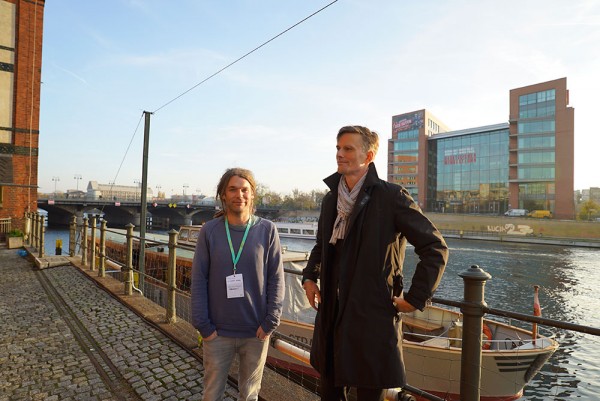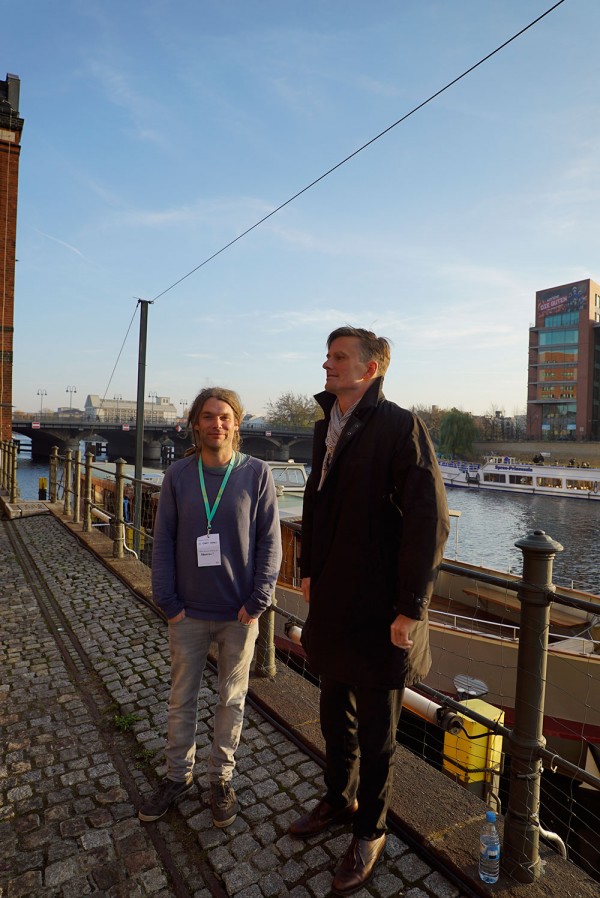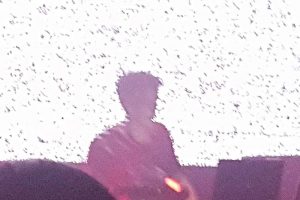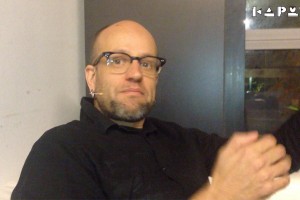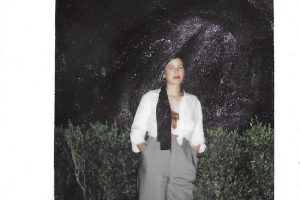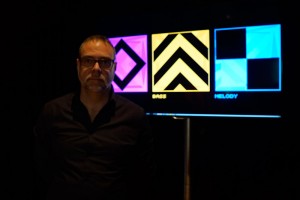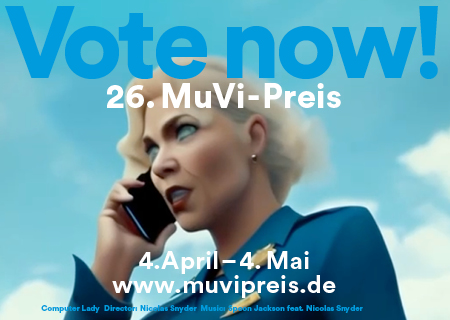„This is too cool not to be supported more.“
At the end of October audio tool innovators Ableton hosted their first three day “LOOP” event in Berlin, a coming-together of leaders in the digital music field where some 600 guests from all over the world got together to talk new technology, share working habits and experience some great performances. It was also an opportunity to discover the latest Ableton products, including the new Push 2 controller and the cool joined-up-music-making app ‘Link’.
Kaput has always been as interested in the “how” as well as the “why” of music-making so editor Thomas Venker took the chance to talk to Ableton-CEO and former Monolake member Gerhard Behles and Ableton Director Sales & Communication Chris Woods (with Olaf Bohn, Global PR & AR Manager of Ableton by their side).
We noticed that when you announced Push 2 you also said there would be a trade-in programme where people get the new one 30% cheaper if they give their Push 1 back. This piqued our interest: you’re offering the traded-in version 1 units to schools and other institutions who could not afford those themselves. This classroom music making is such a great idea, on both levels, marketing/PR-wise and also as a social initiative. Who came up with that? And how did you bring off such an ambitious plan?
Chris Woods: We have worked in education for a long time. We have a huge interest how music is taught at schools and how we could help this process. We are dealing mostly with a lot of professors in high education who are using our software in their courses, wondering what we could offer the school system, what are their needs. When the idea of Push 2 came along – I am looking at it from a sales perspective in mind -, I wondered what that means for all those people who own Push 1. What are they going to do when they hear of the new one? We could create a win-win-situation: the people who already have one get the new one at a reduced price, which should be attractive to them. But by giving the old ones to schools who otherwise wouldn’t be able to afford them we will give a modern direction to music education which in lot of cases is still quite “old school”.
Gerhard Behles: This is Chris’ idea! Usually these ideas pop up out of intellectual noise which happens between people, so you often do not know what exactly comes from whom. For me an influential moment was in experiencing a school class in Los Angeles earlier this year, where Lawrence Grey, a trained teacher who is also participating in Loop, works. As part of his daily schedule he visits all kind of schools and also runs a studio where he brings school kids together. We ended up in one of the classes in one school – and it blew my mind. I never figured there is this power in music education around these tools. I was completely oblivious. It never occurred to me that that could actually not only work but have such a huge impact on the kids. It’s so much more appealing to kids to learn music with tools that help them sound like the music they already love. I saw it in action and could not believe it. This is too cool not to be supported more.
History proves the power of this really, doesn’t it. Proximity is everything… Statistically it seems quite unlikely that three kids sitting next to each other in a school in Detroit would be super talented and will give birth to Techno. Yet somehow Juan Atkins, Derrick May and Kevin Saunderson aka the ‘Belleville Three’ did so. Why? Because they inspired each other and that pushed them on. So helping this process at schools could be a huge encouragement.
Gerhard Behles: I think so. Lawrence does not focus on the gear and the technology at all. Those kids have no problem with the technology anyway, they pick up a gear and software in no time cause they grew up on cell phones and apps, it is a piece of cake for them to master a computer program. Their problem is to have the opportunities. When a guy comes in and tells them rough basics they immediately produce a piece of music afterwards. In the class I saw, a third grade one, the topic was sampling. Pretty advanced for a third grade, right? He was like: „Today we´re gonna sample, that means any sounds you hear in this room could be your instrument. What sounds could you imagine making?“
Chris Woods: I met a few teachers as well. There is one particular, very inspiring teacher I met who came out of the classical music education programme in which the idea was to teach for the rest of his life one thing – in the US there are three types of music courses at school that counts towards graduation credits: Marching Band, School Choir and Music History. He got into Aphex Twin and Warp Records himself at home and started to think how this would apply to a class room. He realized that the old system is all about learning a classical musical instrument and standing up on stage and playing it at front of people. That matches my music education as well, I studied music all the way through to degree level: you learn an instrument and they teach you to become a virtuoso and then you have to learn music theory and music history in order to become better. Composition doesn’t come into it. So he brought this into the class room. He started it really small, at that time 17% of his kids were involved in any music class. And now, eight years later, 70% are going through a music class. It hasn’t affected the traditional music going on, it is just giving them some additional ways to express themselves which don´t necessarily include standing on a stage in front of class-mates. Most of the people I studied music with couldn’t compose a piece of music if they tried. They can perform and play an instrument, but composing and improvisation does not come through that. That’s the powerful thing: you give those kids a different way to express themselves.
And you’re getting artists to help bring the idea to life in the kids’ communities right? Like for example taking the technology to the youth centres artists grew up at and work there on a workshop with the kids. You’re taking Push controllers and Ableton Software to places where “musical education” is not yet on the map.
Gerhard Behles: It would be wonderful if we managed to bring this to people who would otherwise not get into doing music. That’s the dream. As many as possible. I am not expecting that this will generate a new wave of chart/hit producing people, that is not the point. You could see in action the light of the young people, this is an experience, whether or not they will continue with music, maybe it is forgotten in one year´s time, but still it has an impact on them. It does something to their brains, I don’t know what exactly that is, but it creates new opportunities. Also they learn to collaborate – Lawrence puts the kids together in teams of three to make a song together.
Chris Woods: Often he collaborates with people from completely different socio-economic backgrounds. It is a nice system he has been going on: he goes in a school, either a poor, a rich, a private one and he delivers these music lessons – kids from poor backgrounds could attend for free and it is financed by the parents from the kids from richer schools. By that they have this amazing collaborative music experience with kids who could not have had that otherwise. Which is fantastic.
He also offers an extra layer where he teaches the teachers at the same time. So he might stick in the school for one year, and by the time he leaves a teacher who could´t teach that system before now can.
How many people do you think will trade in? And how many artist do you have on the list who will participate as curators?
Chris Woods: We honestly have no idea as we have never done something like this before. We do not expect a number in the tens of thousands. About distribution, the news is not really out yet to the public, but we have talked to some people already – the same people we share our products to get feedback with. And it is amazing how many teachers are coming out of the woodwork and are really interested in using that now in the classroom as they had not the budget to use the gear in the past. I expect there will be a layer of people who find us through the launch and will reply afterwards – the ones who use the software at home or know someone who does. The big challenge is what happens to the rest of them. Again, I have no idea how many that will be. What we really wanna avoid, and that is why we are not in a rush in the distribution department, we do not want them to gather dust on shelves somewhere. The teachers are really enthusiastic at first but then they realize it is really hard and that they maybe can’t do it. That’s why we wanna use our networks for that. The teachers understand that there needs to be a change in music education when the kids should be engaged – but they don’t know how to do it. I am sure we could provide them to get this off the ground. We are lucky enough to have a network around the world who is up for getting behind that.
Especially when the artists bring the Push controllers to their old schools and neighbourhoods themselves and tell the kids their personal success story: „I did not expect to make a life as a musician, but, hey, that’s exactly what I am now!“ This will mean a lot to them.
Chris Woods: Olaf Bohn who is managing our artist relations (and sitting next to us while having this conversation) is testing the concept with a few of them already and there is lots of interest from them: going to schools, giving something back, how inspiring for a kid is that!
To come to the economic side of that cultural idea, even considering that each controller traded in means also a sold new one, this must cost you a fortune?
Gerhard Behles: I guess the accounting folks can handle the numbers, that is not me. We have done enough calculation to know this is not going to ruin us. But we do not know much more.
Chris Woods: You can’t determine the divergence. We have no idea how many owners of the original one would have bought a Push 2 without the programme. We are not able to find out if there is a benefit or loss compared to that situation – we are more focused on the impact.
Feeling good about an idea is already the first step in the right direction.
Are you also planning to do workshops yourself as you both have musical backgrounds?
Gerhard Behles: I am not sure that I am a good teacher. But, I haven’t tried.
I was talking to Robert Henke, your old partner in Monolake, yesterday about this new collaborative software solution called Link. I forgot to ask him this, but I´ll take the chance now with you Gerhard: do you revisit your old Monolake ideas sometimes with the new technical tools you have developed?
Gerhard Behles: Yes. Mentally for sure. I wouldn’t sit down and recreate something old, why? But of course you process that in your mind all the time: how would this have been? How would this have worked? Still, where a lot of the inspiration comes from are past frustrations. Why does that has to be so hard?
Chris Woods: Especially as various people are going through that same process. So many people are using Ableton and bring in their past situations.
On that point, how do you work out which direction to go in when developing new products? There are so many different artists bringing in their experiences and opinions – how do you decide the direction? Is there an inner core who decides the conclusions to take from all this input and the line of action to take?
Gerhard Behles: I am telling you: this is a challenge. It is not like we have no doubts. It would be nice to have a clear process, but it is not like that, it is messy. It is about influences through various channels. It is never clear. I would say: we are still working on that to figure it out. It is a very collaborative process for sure, not a situation where someone makes the call and boom that is it. No sense of dictatorship, more a challenge how to get this choir of many voices to speak to something which ultimately ends up being one thing.
Chris Woods: We have the luxury of time. Not every company has. We can try stuff out and test it with people, going deeper, taking longer to define what we are doing.
Gerhard Behles: We are also lucky to not have too much money. Cause when you have too much, you end up doing everything and never say no. You are not focusing so well. As we are still set up moderately with regards to resources – for what we are doing in the world, for how many people we serve -, we have to be very disciplined what to cut and what to do. It makes people think: this might be my pet feature, but is it really that important?
Utopias take time to build I guess. In the zig-zagging from plan to realworld product, how does it feel when you end up on the other side?
Gerhard Behles: That is a nice way to put it. I see it always like that: you walk and for that you take step by step but of course you know where you wanna go, you have a goal where you wanna end up. But in this situation which is about the future, or let’s say possible futures I think what happens is: every step you readjust the target. After each step you find a new situation, time has passed, the world and we have changed, there are new fascinations. It is a moving target, but it does not move too much. We know the area we will end up and how it looks more or less but there is quite some room to shift.
Do you find the time at a certain spot like now to sit down and say: „Oh, we really did well here. That is satisfying.“ Or do you feel always the pressure to go on?
Gerhard Behles: There is a lot of pressure. Not so much external, it is self made. It is the classic angst that musician also have: you have a hit album, that was in our case Live, and you have another hit album, that was Push, and now you want to have another hit album, you do not want to fall short of your own expectations. You wanna stay relevant. This is beyond the money. You do not want to disappoint people.
Chri Woodss: The satisfaction you get by seeing so many people doing wonderful things with the things we make. That is the addiction.
Do you have sometimes listening session where you sit down and listen to music done with your software/gear? From Jay-Z to an obscure underground artist?
Chris Woods: Informally yes, I would say. It does not happen all the time. But there is a lot of sharing of information about the people and artists who use our products: Spotify playlists and stuff like that. More importantly we are sitting down in groups with the people actually doing music. Not just listening to the music…
Gerhard: … also watching it made in the studio.
So you get direct feedback about their challenges, their limitations and also the rewards they get. Are you often surprised what you see when you look over their shoulders?
Gerhard Behles: It is a huge experience every time we encounter these surprises, popping up in unlikely ways. It is also powerful to go to different places and by that seeing artists in their own environments. When you go to them instead of watching them in the lab, sometimes the findings are on a metalevel not so specific. For example when you go and see a young person in the school where he learns to make music you can make observations how he or she uses the software and what goes wrong, what mistakes occur. But I remember one occasion one kid encountered no errors, he made no mistakes, he was perfect, he had no problem. But actually he had one: he had no idea why he was doing music! It really shocked me – that kid had gone to a very expensive school, this is in the States, where people pay for their studies, but the school has failed totally in giving him any sense of purpose. So we stay open-minded – you have to leave your narrow focus behind and think with a wider focus. You have to go where the users are.
Chris Woods: With the release of Push 2 we’ve got a video we were thrilled to make. For the first time we could capture someone in creative flow in the studio by filming him with a camera. He is an amazing musician, Jonathan Stein, and he was comfortable to do this with cameras in the room and he was able to forget that they are there and make this piece of music. When we went through the footage and asked him what was going through his mind at the time, we discovered a lot of metaphors that he used. He throws out words that describe his goal, the music he tries to make. It is so brilliant when you find people who could verbalise in this way and pass on this information to other people. Because this is the missing bit. So these kids could learn music software and how to use Push and how technology can make abstract ideas into real ones.
I was talking to John Stanier of the Battles, a band you recently also documented in their process of working with Ableton. He mentioned that they put maps on their studio walls to mark their individual narratives of their music. For example he compares his drumming to a short story of Edgar Allen Poe while another member has the association of a cheesecake for his part. For some external person these are weird references, but for them they work in shaping their music. A band creates a language nobody else understands: „We should do more Edgar Allan Poe and less cheesecake“. For them this works, other might think: let’s get them some help.
Gerhard, Chris, your customers and audience are all over the world and you somehow target everybody from a 15-year-old kid to the old ones who still wanna do music.
Olaf Bohn: Let me answer this. Our main audience is between 28 and 35 years old. But it starts under 15, when you think of the school programmes.
I wonder what this means for your daily work. Would it make a difference for you to only produce for Japanese people or Chilean or Canadian? How big is the impact of the, let´s call it „global village“, on your brand definition and the products you are developing?
Gerhard Behles: I can get myself in trouble here, but ultimately we make it for ourselves. That is the naked truth. There is a lot of rationalisation going on, but the original impetus is always someone wants it for himself and then they make it – so other people also want it. But it does not go back to a design by a target group. It is not like: we gonna make something for the Japanese market, so how do they look, what do they eat… Making something specifically for a target market or territory would not play to our strength.
Chris Woods: What you do see though are differences between the countries in the way people use the products we make. Let’s take Japan as an example: I was in Tokyo once and lucky enough to attend a Max/Cycling 74 (a DIY synth/effect building platform) meeting. I turned up to this meeting at Superdeluxe club in Tokyo and there were over 700 people there. At a Max/MSP meeting! You’d never get that here. It is much more nerdy there, people are so into building their own tools.
So looking at the way people use your stuff, you see differences?
Gerhard Behles: Massive differences. It is difficult to come up with an example as I’d hate to stereotype. But sometimes it is stunning: how could they be so different in the use of the same equipment? But the music itself is also so different, let’s say between the States and here in Europe. Huge differences what people listen to. It is not true that the world is a global village. They listen to entirely different music in Los Angeles and Berlin. Deeply defined within cultures and sub-cultures and genres and sub-genres that are unknown to us. And then you go to Brazil and again experience a totally different world we know nothing about.
Gerhard, Chris, thank you for your time.







